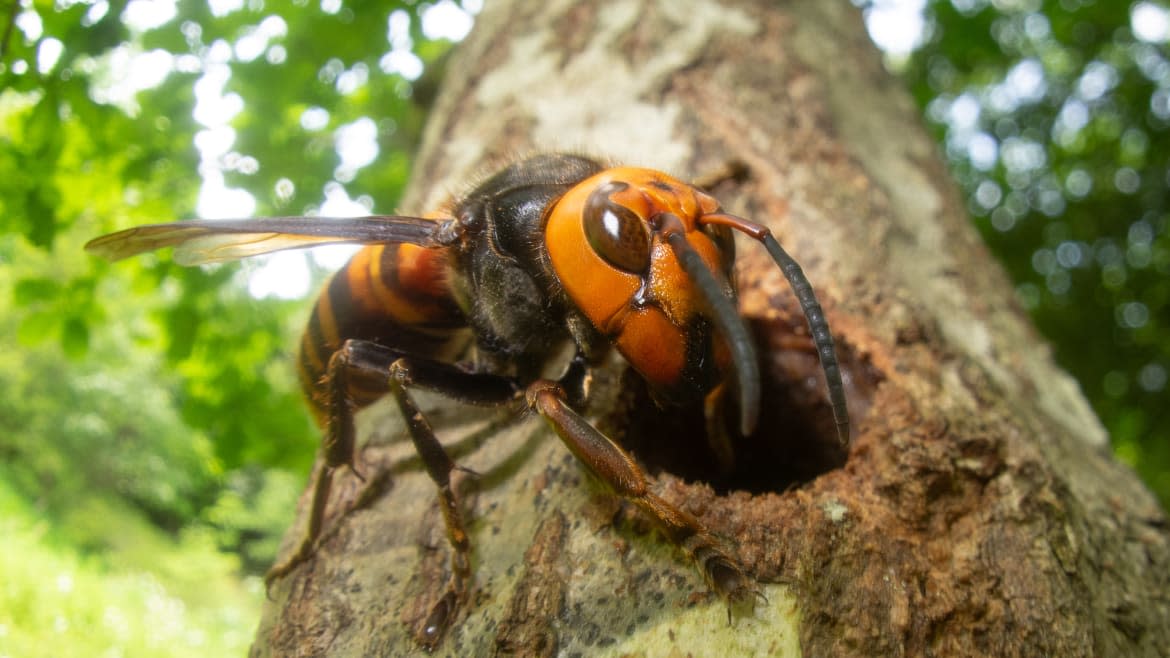Sex Traps Might Finally Help Us Eradicate Murder Hornets

It’s been nearly three years since the Asian giant hornet made its terrifying debut in the U.S. This yellow and black insect, about the size of two stacked hockey pucks, earned itself the moniker “murder hornet” thanks to its ravenous appetite for honey bee larvae. Eradication efforts have been lackluster as scientists work to pinpoint where these hornets set up shop and what attracts them.
As it turns out, sex just might be the answer.
In a new study published March 14 in the journal Current Biology, a group of researchers in California and China uncovered the key ingredients that make up the pheromones of the Asian giant hornet queen and the role they play in the species’ reproductive habits. The new findings could lead to a solution that snips a hornet’s line of succession right before the queen and her male underlings can do the deed—meaning we might finally have an effective way to trap these invasive insects and prevent them from wreaking more havoc on honeybees and crops.
Murder Hornet Season Is Here and Scientists Are Flying Blind
Insects have several different pheromones they use to communicate within the species about food or raise warnings about impending threats. They’re also really important to bug sex life—and few things make for a more lethal trap than the prospect of mating.
The researchers were able to identify three major chemicals that comprise the Asian giant hornet queen’s pheromone: hexanoic acid, octanoic acid, and decanoic acid. The team then created traps laced with these chemicals and placed them near Asian giant hornet nests. The traps only captured male hornets, leading the researchers to realize the queen’s pheromones served as a really alluring chemical booty call.
“The males are drawn to the odors of the females since they typically mate with them near their nests,” said James Nieh, a UC San Diego biologist and co-author of the study, in a press release. “In two field seasons, we were able to rapidly collect thousands of males that were attracted to the odor.”
Information on the pheromone’s chemical blend is publicly available and Nieh hopes that others will “take the protocol we have established and test this method.” It’s still unclear how well these traps will work over longer distances—Asian giant hornets have been reported as far as Canada and in the Pacific Northwest—but Nieh believes they have a radius of up to nearly a mile. And with many traps in place, that could help spread the pheromone’s hypnotic effect over a region potentially infested with giant hornets.
The bigger question the researchers hope to answer through these sex-baited traps is how the Asian giant hornet has been able to spread so rapidly. “We know where they have been found, so the big question is whether they are expanding,” Nieh said. “Where is that invasion front?” Hopefully, with a bit of help from nature’s strongest evolutionary drive, we will be able to find out.
Got a tip? Send it to The Daily Beast here
Get the Daily Beast's biggest scoops and scandals delivered right to your inbox. Sign up now.
Stay informed and gain unlimited access to the Daily Beast's unmatched reporting. Subscribe now.

